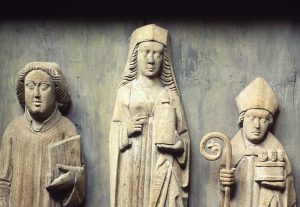Mapping medieval sculptures: Part 4. Databases, objects and research
Postat den 6th February, 2024, 08:55 av Sofia Lahti
Sofia Lahti, Tampere University
The sculptures of Ii and Lavansaari are so seldom mentioned in published literature that they might not have come to my attention if they weren’t included in the two regional museums’ collections databases. Although the sculptures have lost their original “homes”, the museums are committed to maintaining and protecting their existence. Even in the case of the Ii sculptures, where the museum was unable to protect them from the destructivity of war, they are still part of the collections, where the record of their former existence remains.

Being registered in a collection data management system is not in itself a guarantee of any particular level or quality of description, analysis or documentation. The registered information concerning the object may be precise, up to date and multilayered, or minimal, patchy, outdated, or any mixture of those. Inevitably some objects will always have a richer, more detailed register than others. The registered content is a result of several factors, different generations of museum professionals and eras of different archival practices, circumstances and interests. Nevertheless, being registered is a guarantee of the object not being entirely lost, forgotten, or out of reach. If an object is in a museum collection but not on display, nor registered in a database or some other cataloguing system, it can be defined as dormant, but it is really as good as inexistent: nobody will know of its existence, and it cannot be found.
Unlike a research database like the Mapping Saints, a museum collections database is primarily a tool for managing the collections, where data concerning an object’s location and physical dimensions is crucial. In some museums, this kind of logistic data is kept in a different database from the information related to the content and context of the objects. Ideally, the same database could serve the interests of collections management, research, and educational or exhibition work by containing all essential information about each item in a concise form, with references to all available literature or sources.
Naturally, a serious analysis of a physical artefact cannot be completed within databases even with the fullest record of data. Artefacts need to be seen in order to be understood; even 3D scans do not substitute the actual object. With lost artefacts or images, however, the impossibility of seeing can only be compensated by other sources. Comparing data on lost images or objects to images of existing ones is a useful option that needs to be used cautiously.
Resources for research and cataloguing in museums are nearly never sufficient in relation to the size of the collections, which is why collections databases are often lagging behind on up-to-date information. Sometimes it also happens that new, research-based information on collection items does not reach the museum. In the worst case, this leads to a situation where the limited resources are wasted if the already existing information on a collection item is not found and the same research work ends up being repeated. In the best case, the situation is the opposite and resources are multiplied, when research and collections management benefit from each other. This is why it is so important that museum professionals and researchers – both ones employed in the museums and outside – remember to collaborate. As long as all the relevant information is meticulously kept, new research is possible and new understanding can be gained, even decades or centuries after the objects themselves may have disappeared.
Det här inlägget postades den February 6th, 2024, 08:55 och fylls under archives

